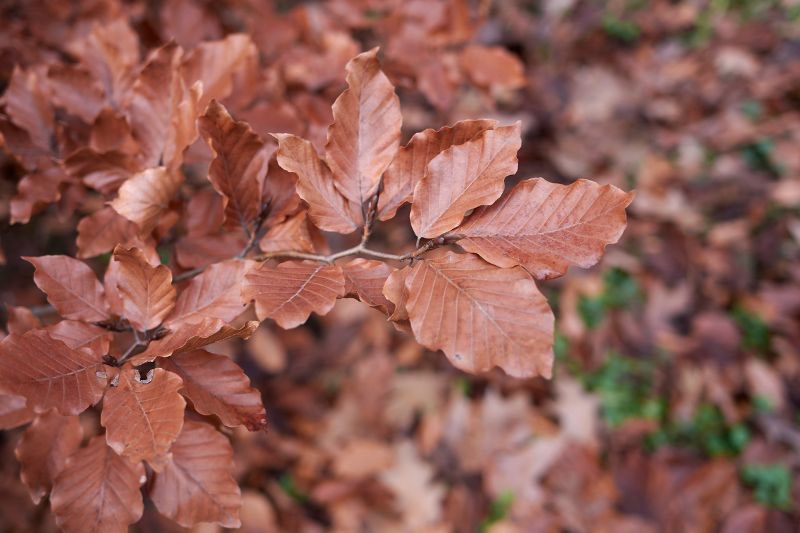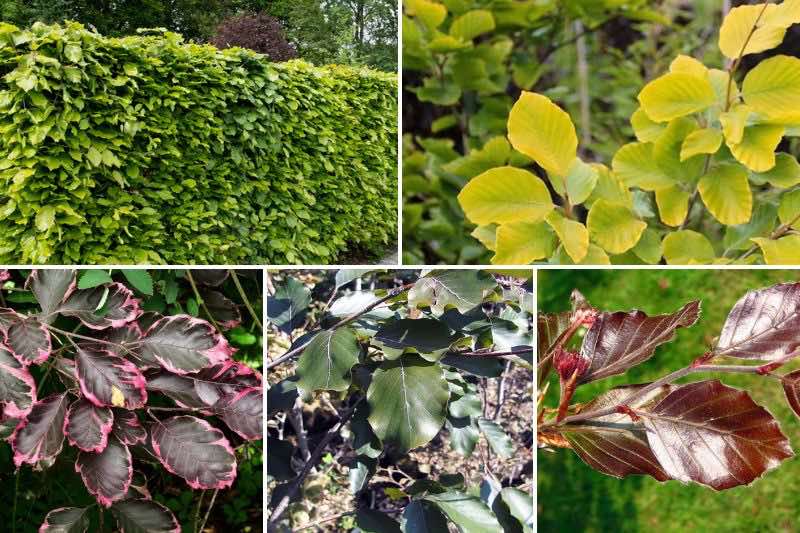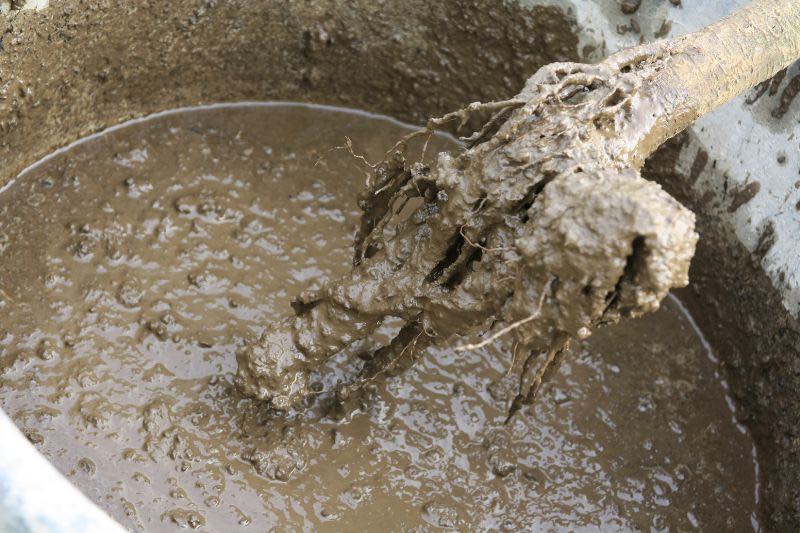Beech is a native tree commonly found in our forests. In the garden, it is widely used to form hedges. It has many qualities that allow creation of a handsome living screen and boundary:
- rapid growth;
- tolerance of pruning;
- low soil requirements, provided it is well drained (does not retain excess water);
- marcescent foliage (that dies but remains on the tree until new shoots appear in spring), which stays dense while letting light through in winter;
- long lifespan;
- good frost resistance.
Here are our tips and guide to successfully plant and maintain a beech hedge in the garden.

Which beech varieties to choose for a hedge?
Best beeches for hedging
Several beech varieties are suitable for creating a hedge:
- common beech or fayard (Fagus sylvatica), with its dense foliage that turns attractive coppery shades in autumn;
- the variety ‘Dawyck Gold’, with its columnar silhouette and bright golden-yellow leaves in spring;
- ‘Atropurpurea’, also called purple beech in reference to the colour of its foliage;
- ‘Riversii’, another purple beech with slower growth, whose leaves tend towards violet and contrast beautifully with silvery‑grey bark;
- the cultivar ‘Purpurea Tricolor’, a beech with striking purple foliage variegated with pink and white.
You can choose a single species to form your beech hedge, or mix colours for a less monotonous, less formal effect. Try alternating green‑leaved beeches and purple beeches for a more dynamic, decorative hedge. It is also possible to create a purple beech hedge by mixing several of these coloured‑leaf varieties.

How are beeches supplied?
Beeches are generally available in nurseries or garden centres in two forms: bare roots or in containers (buckets, pots).
Bare roots are plants lifted from the ground just before delivery, which is why they are only available during the trees’ dormant period, between late autumn and late winter. They have the advantage of being much more economical to buy and offer good establishment. However, they must be planted very quickly after purchase to avoid root desiccation and require some preparation beforehand (pralinage).
Container-grown beeches are available almost year‑round but are more expensive to buy. They can wait before being transplanted and give an instant effect, perfect if you are in a hurry or simply want to fill a section of hedge. Purchased in a bucket of about 10 cm, beeches will be cheaper but will require more patience before the trees reach a useful height.
Choice of supply form will therefore depend mainly on:
- planting period;
- desired installation time;
- budget.
When to plant a beech hedge?
Optimal planting periods for a beech hedge are autumn (October–November) or early spring (March–April).
Bare‑root beeches should be planted as quickly as possible after purchase.
In theory, container‑grown beeches can be planted throughout the year, except during frost or drought periods.
Choose a calm day, not windy, not rainy and without intense heat. Avoid planting immediately after heavy rain or a frost period, as soil may still be cold and waterlogged.
Where to plant a beech hedge?
Beeches are not very demanding regarding soil type, but some precautions are required. The substrate must be well drained, meaning it does not retain excess water. If necessary, lighten heavy, clay soils.
Soil should be fairly cool (slightly moist) and rich in organic matter. It can be slightly calcareous or sandy, but not acidic.
Beeches are not suited to very hot, dry climates, which is why they are generally not recommended for hedges in southern regions with such conditions.
Regarding exposure, purple beeches prefer full sun, while green‑leaved beeches can be placed in partial shade.
Finally, note that an overly windy exposure may cause leaves to blow off in autumn–winter or damage the shallow root system.
Steps for planting a beech hedge
Prepare the soil
The soil should be prepared and cleared before planting. Once the area is marked out:
- Equip yourself with a hoe to remove grass and work the surface soil;
- Remove adventive plants (“weeds”) using a hand hoe or weeder;
- Use a spade to loosen compacted soil;
- Remove remaining plant roots, large stones, etc.;
- Optionally add well‑rotted horse manure or well‑matured household compost to improve the area.
If preparing the soil in advance, cover it with cardboard (held down by bricks or stones) or a tarp so it stays protected and free of new adventive shoots until planting.
Assess planting distances
If you want a fairly occlusive hedge, beeches should be planted fairly close together. Planting density depends on the height of your beeches and their supply form. As a simple rule, allow about 50 cm between each plant, equivalent to roughly 2 beeches per metre of planting.
Regarding hedge position, place it at least 50 centimetres from the property boundary if you expect it to be under 2 metres. For a hedge over 2 metres high, a distance of at least 2 metres should be observed.
Planting can be in a single row to create a narrow hedge, or in two rows, either parallel or staggered, for a fuller, more natural appearance.
Prepare bare‑root beeches
Bare‑root plants require a little preparation before planting: pralinage. This consists of coating the roots with a mixture that will hydrate and protect them, optimising establishment.
This root dip can be bought ready‑made or homemade from soil, rainwater and manure. Carry out this step about 24 hours before planting.
For more information: “Coat roots of trees and bushes with pralin”.

Prepare potted or bucketed beeches
Container‑grown beeches should simply be plunged into a bucket or basin of water for about 1 hour to thoroughly rehydrate the rootball and ease removal. Then take the plants out of their pots and gently tease apart the root system.
Make a light pruning or scarify the rootball if you notice formation of a root‑bound mass. For more information: “Root girdling”.
Planting steps
If needed, to ensure a straight hedge, mark a line with string tied to a few stakes (or use a guide line).
- Using a spade, dig planting holes (or a trench) to a depth of about twice the size of the rootball.
- Install a drainage layer at the bottom of the holes, made of gravel, terracotta shards or clay pebbles.
- Mix the excavated garden soil with a handful of well‑rotted manure or compost for each hole to enrich and improve soil structure.
- Place about one‑third of this mix at the bottom of the holes.
- Set the rootball upright in the holes, then backfill with the soil mixture until the entire root system is covered.
- Firm down with your feet.
- Water generously.
- Apply an organic mulch (straw, wood chips, etc.).
Note: container‑grown beeches may take a little longer to establish and will need more regular watering, especially during dry periods.

How to care for a beech hedge?
Number of prunings will depend on the look you want for your beech hedge and its growth. For a natural effect, one annual prune is usually sufficient. For a tidier appearance, prune more regularly. In autumn or late winter, remove poorly oriented branches to give a more harmonious silhouette if needed. Following recommendations of the League for the Protection of Birds, avoid pruning between mid‑March and the end of July. Always use cutting tools (pruning shear or hedge trimmer) that have been disinfected beforehand to prevent spread of diseases.
During first 2–3 years, water the hedge in periods of drought. Mulch applied at planting will help conserve moisture and reduce evaporation. Renew mulch as it naturally decomposes.
Particularly on young, sensitive plants, watch for fungal diseases (such as canker, powdery mildew or honey fungus/Armillaria), and attacks by aphids, scale insects, leafhoppers or beech weevils.
Necessary equipment
For planting and maintaining a beech hedge, have the following ready:
- hoe, hand hoe or weeder;
- spade;
- tape measure;
- string or guide line and stakes (optional);
- pruning shears or hedge trimmer.































![[plantes nom="hêtre commun" variété="vert" taille="1,5 mètre"]
To create a beech hedge, you can plant {glossary} common beech plants with a height of 1.5 meters. Planting a hedge of Common Beech (Fagus sylvatica)](https://www.promessedefleurs.ie/blogwp/wp-content/uploads/2023/02/Comment-faire-une-haie-de-hetres-.png)
Comments